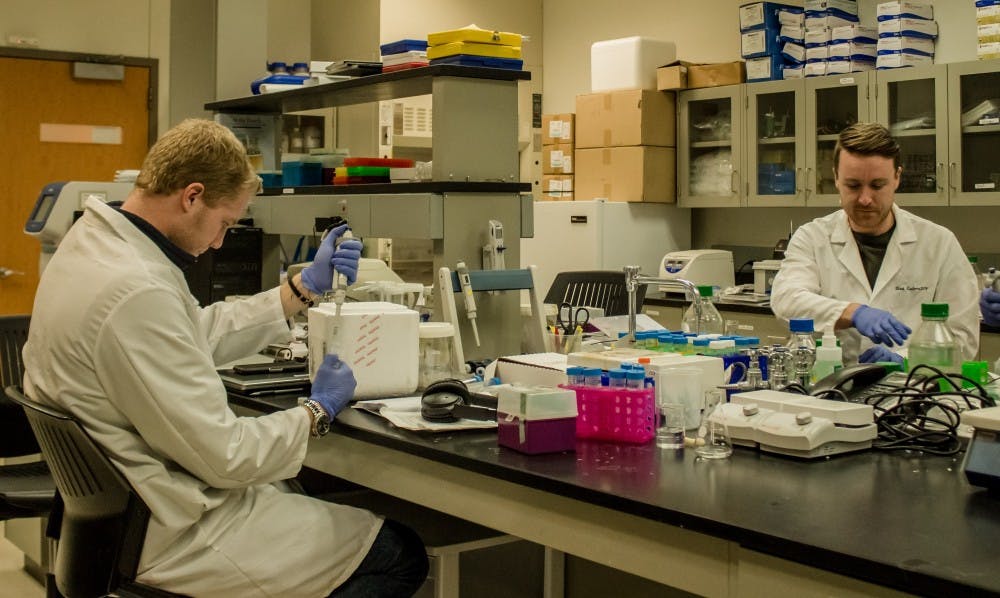Faculty, students dedicated to identifying catalyst for Alzheimer's disease

Limerick, Ireland graduate student Tomas Barrett (right) reaches for equipment on Jan. 31 in the Health Professions Building. Barrett may dedicate up to 60 hours a week to working in the lab.
Neuroscience program faculty member Kevin Park thinks his work studying Alzheimer’s disease is like examining the aftermath of a car crash.
“Alzheimer’s disease is what you see afterward,” he said. “You have accident investigators trying to figure out what led to this effect. It could have been many things.”
Park and his team of graduate and undergraduate students are the investigators on the scene, trying to initiate Alzheimer’s disease in a mouse model so the catalyst for the disease can be identified.
“By having a model that is quite constrained and systematic, we are trying to figure out whether we can identify a specific mechanism that causes this (disease),” Park said.
The aftermath of Alzheimer’s disease is observed by three characteristics in an affected brain, Park said: plaques, tangles and neuronal loss — otherwise known as cell death.
Plaques are a build-up of proteins between nerve cells in the brain. Tangles cut off nutrients to others cells.
Neuronal loss, Park said, is a little more complicated.
“Typically, neurons (are) post-mitotic, which means they are not going to multiply and divide,” said Ireland graduate student Tomas Barrett.
In a brain affected by Alzheimer’s disease, the neurons are given instructions to do so, which instead causes cell death.
Barrett said research has focused on targeting plaques because they appear first, making researchers lean toward hypotheses supporting information suggesting plaques cause the tangles and neuronal loss. Still, nothing is confirmed.
“There’s research coming out suggesting that may not be the case,” Barrett said.
Park said the goal is to see if they system can be manipulated.
“Then the goal is to identify the pathway so we can pick apart the key pathways that are involved in Alzheimer’s disease,” he said.
The lab is focusing on pointing toward the cell cycle — unregulated asexual cell reproduction as seen in cancers — as a contributor to Alzheimer’s disease.
“We’re looking at whether we can initiate the cell cycle in the mock we have (and if) that will produce Alzheimer’s like in phenotypes.” Barrett said.
Park co-authored “Conditional Neuronal Simian Virus 40 T Antigen Expression Induces Alzheimer-Like Tau and Amyloid Pathology in Mice” in 2007. The scholarly article reports the use of a cell cycle activator commonly used in cancer research, TAg, has been used to create characteristics of Alzheimer’s disease in the lab’s mouse model.
“(It) lends credence to the concept that the origin of (Alzheimer’s disease) resembles that of cancer,” the article states.
Eleven years after publication, the research is still a long way away from being provable in a lab environment.
“We’re not saying necessarily that the cell cycle causes (Alzheimer’s disease),” Barrett said. “Because we see it in the human brain at autopsy, we don’t know whether it’s a consequence or a cause.”



